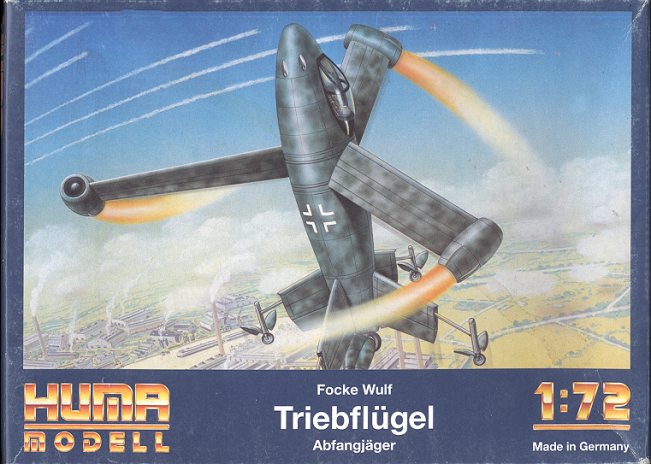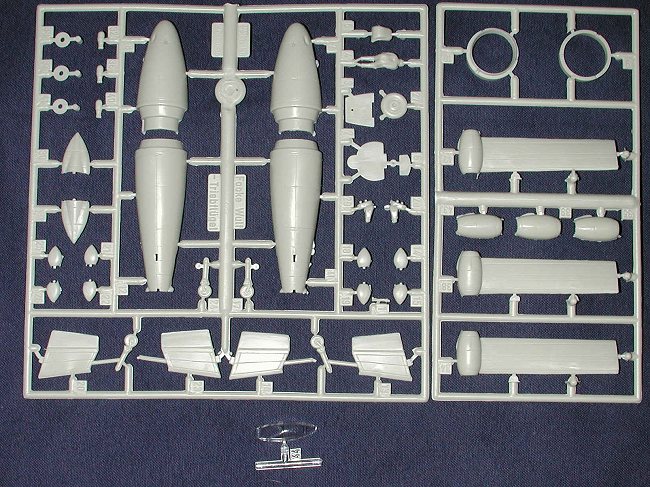
|
KIT: |
Huma 1/72 Focke-Wulf Triebflügel |
|
KIT # |
3502 |
|
PRICE: |
$29.98 |
|
DECALS: |
See Review |
|
REVIEW & |
|
|
NOTES: |

|
HISTORY |
German designers were nothing if not innovative. There were a number of highly unusual aircraft designs to fly from the drawing boards in the the mid-late war periods. One of the more interesting came from Focke-Wulf. Focke-Wulf spent a lot of design hours developing possible VTOL (Vertical Take Off and Landing) aircraft. Several had circular wings and were powered by twin piston engines or by turbojets. Probably one of the most wierd was the Triebflugel. This particular aircraft had a ramjet on the end of what were basically rotating wings.
Ramjets do not operate until a relatively high speed has been attained (around 250 mph), so some method of getting the freely rotating wings up to speed had to be developed. Either booster rockets or some sort of auxiliary engine would have been needed. The idea was to develop a point defense fighter that would be able to quickly get airborne to attack incoming enemy aircraft. The VTOL requirement would have meant that they could be operated from any flat surface, such as around an industrial complex. They could even have been operated from ships.
Typical of early work on VTOL aircraft. The biggest problem would have been landing the beast. After the war, a number of VTOL aircraft of the tail-sitting configuration were developed by the US and even with the high skills of an experienced test pilot, landing was very difficult. To expect the poorly trained Luftwaffe pilot of the time to be able to perform such a function would have resulted in disaster.
|
THE KIT |

This is one of Huma's more interesting kits and also one that was developed prior to the superfine injected fret that the newer models have. It is in Huma's grey plastic with finely engraved panel lines. It is pretty obvious that this has been a popular model kit as my example showed several of the signs of a wearing mold. Specifically flash and rather prominent mold seams on some of the parts.
The interior is quite basic consisting of nothing more than a floor, rear bulkhead, seat, stick and small instrument panel. There are basically three parts to this kit; the nose section, the tail section and the rotating wings. The tail section will be the most complicated to build with the landing gear and those small gear doors to glue in place. Fortunately, it will be relatively easy to have everything squared away when building it. Though you wouldn't consider a tail-sitting aircraft to need weight, I would put some in the lower section to keep it from easily tipping over. It seems from the instructions that the wings are supposed to be free moving, so some petroleum jelly would be a good ideal to keep things from being accidentally glued.
The instructions are similar to other Huma Luft '46 kits in that there are 10 exploded view construction steps and a color drawing of the finished model. In this case it in a heavily mottled pattern of RLM 74 and RLM 75. There decal sheet is unremarkable, offering fuselage crosses and an instrument panel. The decals are very matte and have lots of carrier film that will need to be removed.
Overall, it should not be that difficult to build. Huma kits have generally been pretty well engineered and can be built into very nice models straight from the box (like you are going to find aftermarket stuff for this kit!).
Review kit courtesy of me and my wallet!
If you would like your product reviewed fairly and quickly by a site that averages over 2,200 visits a day, please contact me or see other details in the Note to Contributors.